Yamaha SR400 Manual

q Read this manual carefully before operating this vehicle.
OWNER’S MANUAL
SR400
2RD-28199-E0

EAU46091
Q Read this manual carefully before operating this vehicle. This manual should stay with this vehicle if it is sold.

INTRODUCTION
EAU10103
Welcome to the Yamaha world of motorcycling!
As the owner of the SR400, you are benefiting from Yamaha’s vast experience and newest technology regarding the design and manufacture of high-quality products, which have earned Yamaha a reputation for dependability.
Please take the time to read this manual thoroughly, so as to enjoy all advantages of your SR400. The Owner’s Manual does not only instruct you in how to operate, inspect and maintain your motorcycle, but also in how to safeguard yourself and others from trouble and injury.
In addition, the many tips given in this manual will help keep your motorcycle in the best possible condition. If you have any further questions, do not hesitate to contact your Yamaha dealer.
The Yamaha team wishes you many safe and pleasant rides. So, remember to put safety first!
Yamaha continually seeks advancements in product design and quality. Therefore, while this manual contains the most current product information available at the time of printing, there may be minor discrepancies between your motorcycle and this manual. If there is any question concerning this manual, please consult a Yamaha dealer.
EWA10032
 WARNING
WARNING
Please read this manual carefully and completely before operating this motorcycle.

IMPORTANT MANUAL INFORMATION
EAU10134
Particularly important information is distinguished in this manual by the following notations:
|
|
|
|
This is the safety alert symbol. It is used to alert you to potential personal injury |
|
|
|
|
hazards. Obey all safety messages that follow this symbol to avoid possible injury |
|
|
|
|
or death. |
|
|
|
|
|
|
|
|
|
|
|
|
|
|
A WARNING indicates a hazardous situation which, if not avoided, could result in |
|
WARNING |
|
||
|
|
death or serious injury. |
||
|
|
|
|
|
|
|
|
|
|
|
|
|
|
|
|
|
|
|
A NOTICE indicates special precautions that must be taken to avoid damage to the |
|
NOTICE |
|
|
|
|
|
vehicle or other property. |
||
|
|
|
|
|
|
|
|
|
|
TIP |
A TIP provides key information to make procedures easier or clearer. |
|
|
*Product and specifications are subject to change without notice.

IMPORTANT MANUAL INFORMATION
EAU10201
SR400
OWNER’S MANUAL ©2013 by Yamaha Motor Co., Ltd.
1st edition, October 2013 All rights reserved.
Any reprinting or unauthorized use without the written permission of Yamaha Motor Co., Ltd.
is expressly prohibited. Printed in Japan.

TABLE OF CONTENTS
SAFETY INFORMATION ................... |
1-1 |
FOR YOUR SAFETY – |
|
Spoke wheels ................................ |
6-16 |
|
|
PRE-OPERATION CHECKS ............. |
4-1 |
Adjusting the clutch lever free |
|
DESCRIPTION ................................... |
2-1 |
|
|
play............................................. |
6-16 |
Left view .......................................... |
2-1 |
OPERATION AND IMPORTANT |
|
Adjusting the brake lever free |
|
Right view ........................................ |
2-2 |
RIDING POINTS................................. |
5-1 |
play............................................. |
6-17 |
Controls and instruments................. |
2-3 |
Starting the engine .......................... |
5-1 |
Adjusting the brake pedal height |
|
|
|
Starting trouble................................ |
5-2 |
and free play............................... |
6-18 |
INSTRUMENT AND CONTROL |
|
Shifting ............................................ |
5-2 |
Checking the shift pedal ................ |
6-19 |
FUNCTIONS ....................................... |
3-1 |
Tips for reducing fuel |
|
Brake light switches ....................... |
6-19 |
Main switch/steering lock................. |
3-1 |
consumption ................................ |
5-3 |
Checking the front brake pads |
|
Indicator lights and warning lights ... |
3-2 |
Engine break-in ............................... |
5-3 |
and rear brake shoes ................ |
6-20 |
Speedometer unit ............................ |
3-3 |
Parking ............................................ |
5-4 |
Checking the brake fluid level........ |
6-20 |
Tachometer ..................................... |
3-4 |
|
|
Changing the brake fluid ............... |
6-21 |
Handlebar switches ......................... |
3-4 |
PERIODIC MAINTENANCE AND |
|
Drive chain slack............................ |
6-22 |
Clutch lever...................................... |
3-5 |
ADJUSTMENT ................................... |
6-1 |
Cleaning and lubricating the drive |
|
Shift pedal........................................ |
3-6 |
Owner’s tool kit................................ |
6-2 |
chain........................................... |
6-23 |
Brake lever ...................................... |
3-6 |
Periodic maintenance chart for the |
|
Checking and lubricating the |
|
Brake pedal ..................................... |
3-6 |
emission control system .............. |
6-3 |
cables ......................................... |
6-24 |
Fuel tank cap ................................... |
3-7 |
General maintenance and |
|
Checking and lubricating the |
|
Fuel.................................................. |
3-7 |
lubrication chart ........................... |
6-4 |
throttle grip and cable................. |
6-24 |
Fuel tank breather/overflow hose .... |
3-9 |
Removing and installing the |
|
Checking and lubricating the |
|
Catalytic converter........................... |
3-9 |
panel ............................................ |
6-7 |
brake and clutch levers .............. |
6-25 |
Fuel cock ....................................... |
3-10 |
Checking the spark plug.................. |
6-8 |
Checking and lubricating the |
|
Kickstarter...................................... |
3-10 |
Engine oil and oil filter element ....... |
6-9 |
brake pedal................................. |
6-25 |
Decompression lever..................... |
3-11 |
Replacing the air filter element...... |
6-12 |
Checking and lubricating the |
|
Seat ............................................... |
3-11 |
Checking the engine idling |
|
centerstand and sidestand ......... |
6-26 |
Adjusting the shock absorber |
|
speed ......................................... |
6-13 |
Lubricating the swingarm pivots .... |
6-26 |
assemblies ................................. |
3-12 |
Checking the throttle grip free |
|
Checking the front fork................... |
6-27 |
Sidestand....................................... |
3-12 |
play ............................................ |
6-13 |
Checking the steering .................... |
6-27 |
Ignition circuit cut-off system ......... |
3-13 |
Valve clearance............................. |
6-13 |
Checking the wheel bearings......... |
6-28 |
|
|
Tires .............................................. |
6-14 |
Battery ........................................... |
6-28 |

TABLE OF CONTENTS
Replacing the fuses....................... |
6-29 |
Replacing the headlight bulb ......... |
6-31 |
Replacing the tail/brake light |
|
bulb ............................................ |
6-32 |
Replacing a turn signal light |
|
bulb ............................................ |
6-33 |
Replacing the auxiliary light |
|
bulb ............................................ |
6-34 |
Front wheel.................................... |
6-35 |
Rear wheel .................................... |
6-37 |
Troubleshooting............................. |
6-39 |
Troubleshooting chart.................... |
6-40 |
MOTORCYCLE CARE AND |
|
STORAGE .......................................... |
7-1 |
Matte color caution .......................... |
7-1 |
Care................................................. |
7-1 |
Storage............................................ |
7-3 |
SPECIFICATIONS.............................. |
8-1 |
CONSUMER INFORMATION............. |
9-1 |
Identification numbers ..................... |
9-1 |
INDEX ............................................... |
10-1 |

 SAFETY INFORMATION
SAFETY INFORMATION
EAU1028B
1
Be a Responsible Owner
As the vehicle’s owner, you are responsible for the safe and proper operation of your motorcycle.
Motorcycles are single-track vehicles. Their safe use and operation are dependent upon the use of proper riding techniques as well as the expertise of the operator. Every operator should know the following requirements before riding this motorcycle.
He or she should:
Obtain thorough instructions from a competent source on all aspects of motorcycle operation.
Observe the warnings and maintenance requirements in this Owner’s Manual.
Obtain qualified training in safe and proper riding techniques.
Obtain professional technical service as indicated in this Owner’s Manual and/or when made necessary by mechanical conditions.
Never operate a motorcycle without proper training or instruction.
Take a training course. Beginners should receive training from a certified instructor. Contact an authorized motorcycle dealer to find out about the training courses nearest you.
Safe Riding
Perform the pre-operation checks each time you use the vehicle to make sure it is in safe operating condition. Failure to inspect or maintain the vehicle properly increases the possibility of an accident or equipment damage. See page 4-1 for a list of pre-operation checks.
This motorcycle is designed to carry the operator and a passenger.
The failure of motorists to detect and recognize motorcycles in traffic is the predominating cause of automobile/motorcycle accidents. Many accidents have been caused by an automobile driver who did not see the motorcycle. Making yourself conspicuous appears to be very effective in reducing the chance of this type of accident.
Therefore:
• Wear a brightly colored jacket.
•Use extra caution when you are approaching and passing through intersections, since intersections are the most likely places for motorcycle accidents to occur.
•Ride where other motorists can see you. Avoid riding in another motorist’s blind spot.
•Never maintain a motorcycle without proper knowledge. Contact an authorized motorcycle dealer to inform you on basic motorcycle maintenance. Certain maintenance can only be carried out by certified staff.
Many accidents involve inexperienced operators. In fact, many operators who have been involved in accidents do not even have a current motorcycle license.
•Make sure that you are qualified and that you only lend your motorcycle to other qualified operators.
•Know your skills and limits. Staying within your limits may help you to avoid an accident.
•We recommend that you prac-
1-1

 SAFETY INFORMATION
SAFETY INFORMATION
tice riding your motorcycle where there is no traffic until you have become thoroughly familiar with the motorcycle and all of its controls.
Many accidents have been caused by error of the motorcycle operator. A typical error made by the operator is veering wide on a turn due to excessive speed or undercornering (insufficient lean angle for the speed).
•Always obey the speed limit and never travel faster than warranted by road and traffic conditions.
•Always signal before turning or changing lanes. Make sure that other motorists can see you.
The posture of the operator and passenger is important for proper control.
•The operator should keep both hands on the handlebar and both feet on the operator footrests during operation to maintain control of the motorcycle.
•The passenger should always hold onto the operator, the seat strap or grab bar, if equipped,
with both hands and keep both feet on the passenger footrests. Never carry a passenger unless he or she can firmly place both feet on the passenger footrests.
Never ride under the influence of alcohol or other drugs.
This motorcycle is designed for on-road use only. It is not suitable for off-road use.
Protective Apparel
The majority of fatalities from motorcycle accidents are the result of head injuries. The use of a safety helmet is the single most critical factor in the prevention or reduction of head injuries.
Always wear an approved helmet.
Wear a face shield or goggles. Wind in your unprotected eyes could contribute to an impairment of vision that could delay seeing a hazard.
The use of a jacket, heavy boots, trousers, gloves, etc., is effective in preventing or reducing abrasions or lacerations.
Never wear loose-fitting clothes, otherwise they could catch on the
control levers, footrests, or wheels |
1 |
|
and cause injury or an accident. |
||
|
Always wear protective clothing that covers your legs, ankles, and feet. The engine or exhaust system become very hot during or after operation and can cause burns.
A passenger should also observe the above precautions.
Avoid Carbon Monoxide Poisoning
All engine exhaust contains carbon monoxide, a deadly gas. Breathing carbon monoxide can cause headaches, dizziness, drowsiness, nausea, confusion, and eventually death.
Carbon Monoxide is a colorless, odorless, tasteless gas which may be present even if you do not see or smell any engine exhaust. Deadly levels of carbon monoxide can collect rapidly and you can quickly be overcome and unable to save yourself. Also, deadly levels of carbon monoxide can linger for hours or days in enclosed or poorly ventilated areas. If you experience any symptoms of carbon monoxide poisoning, leave the area immediately, get fresh air, and SEEK MEDICAL TREAT-
1-2

 SAFETY INFORMATION
SAFETY INFORMATION
MENT.
1 Do not run engine indoors. Even if you try to ventilate engine exhaust with fans or open windows and doors, carbon monoxide can rapidly reach dangerous levels.
Do not run engine in poorly ventilated or partially enclosed areas such as barns, garages, or carports.
Do not run engine outdoors where engine exhaust can be drawn into a building through openings such as windows and doors.
Loading
Adding accessories or cargo to your motorcycle can adversely affect stability and handling if the weight distribution of the motorcycle is changed. To avoid the possibility of an accident, use extreme caution when adding cargo or accessories to your motorcycle. Use extra care when riding a motorcycle that has added cargo or accessories. Here, along with the information about accessories below, are some general guidelines to follow if loading cargo to your motorcycle:
The total weight of the operator, passenger, accessories and cargo must not exceed the maximum load limit.
Operation of an overloaded vehicle could cause an accident.
Maximum load:
150 kg (331 lb)
When loading within this weight limit, keep the following in mind:
Cargo and accessory weight should be kept as low and close to the motorcycle as possible. Securely pack your heaviest items as close to the center of the vehicle as possible and make sure to distribute the weight as evenly as possible on both sides of the motorcycle to minimize imbalance or instability.
Shifting weights can create a sudden imbalance. Make sure that accessories and cargo are securely attached to the motorcycle before riding. Check accessory mounts and cargo restraints frequently.
•Properly adjust the suspension for your load (suspension-ad-
justable models only), and check the condition and pressure of your tires.
•Never attach any large or heavy items to the handlebar, front fork, or front fender. These items, including such cargo as sleeping bags, duffel bags, or tents, can create unstable handling or a slow steering response.
This vehicle is not designed to pull a trailer or to be attached to a sidecar.
Genuine Yamaha Accessories
Choosing accessories for your vehicle is an important decision. Genuine Yamaha accessories, which are available only from a Yamaha dealer, have been designed, tested, and approved by Yamaha for use on your vehicle.
Many companies with no connection to Yamaha manufacture parts and accessories or offer other modifications for Yamaha vehicles. Yamaha is not in a position to test the products that these aftermarket companies produce. Therefore, Yamaha can neither en-
1-3

 SAFETY INFORMATION
SAFETY INFORMATION
dorse nor recommend the use of accessories not sold by Yamaha or modifications not specifically recommended by Yamaha, even if sold and installed by a Yamaha dealer.
Aftermarket Parts, Accessories, and Modifications
While you may find aftermarket products similar in design and quality to genuine Yamaha accessories, recognize that some aftermarket accessories or modifications are not suitable because of potential safety hazards to you or others. Installing aftermarket products or having other modifications performed to your vehicle that change any of the vehicle’s design or operation characteristics can put you and others at greater risk of serious injury or death. You are responsible for injuries related to changes in the vehicle.
Keep the following guidelines in mind, as well as those provided under “Loading” when mounting accessories.
Never install accessories or carry cargo that would impair the performance of your motorcycle. Carefully inspect the accessory before
using it to make sure that it does not in any way reduce ground clearance or cornering clearance, limit suspension travel, steering travel or control operation, or obscure lights or reflectors.
•Accessories fitted to the handlebar or the front fork area can create instability due to improper weight distribution or aerodynamic changes. If accessories are added to the handlebar or front fork area, they must be as lightweight as possible and should be kept to a minimum.
•Bulky or large accessories may seriously affect the stability of the motorcycle due to aerodynamic effects. Wind may attempt to lift the motorcycle, or the motorcycle may become unstable in cross winds. These accessories may also cause instability when passing or being passed by large vehicles.
•Certain accessories can displace the operator from his or her normal riding position. This improper position limits the free-
dom of movement of the opera-
tor and may limit control ability, 1 therefore, such accessories are
not recommended.
Use caution when adding electrical accessories. If electrical accessories exceed the capacity of the motorcycle’s electrical system, an electric failure could result, which could cause a dangerous loss of lights or engine power.
Aftermarket Tires and Rims
The tires and rims that came with your motorcycle were designed to match the performance capabilities and to provide the best combination of handling, braking, and comfort. Other tires, rims, sizes, and combinations may not be appropriate. Refer to page 6-14 for tire specifications and more information on replacing your tires.
Transporting the Motorcycle
Be sure to observe following instructions before transporting the motorcycle in another vehicle.
Remove all loose items from the motorcycle.
1-4

 SAFETY INFORMATION
SAFETY INFORMATION
Check that the fuel cock (if
1equipped) is in the “OFF” position and that there are no fuel leaks.
Point the front wheel straight ahead on the trailer or in the truck bed, and choke it in a rail to prevent movement.
Shift the transmission in gear (for models with a manual transmission).
Secure the motorcycle with tie-downs or suitable straps that are attached to solid parts of the motorcycle, such as the frame or upper front fork triple clamp (and not, for example, to rubber-mount- ed handlebars or turn signals, or parts that could break). Choose the location for the straps carefully so the straps will not rub against painted surfaces during transport.
The suspension should be compressed somewhat by the tie-downs, if possible, so that the motorcycle will not bounce excessively during transport.
1-5

DESCRIPTION
EAU10411
Left view
1, 2 |
3 |
4 |
5, 6 |
2 |
|||||
|
|
|
|
|
|
|
|
|
|
|
|
|
|
|
|
|
|
|
|
|
|
|
|
|
|
|
|
|
|
|
|
|
|
|
|
|
|
|
|
|
|
|
|
|
|
|
|
|
|
|
|
|
|
|
|
|
|
|
|
|
|
|
|
|
|
|
|
|
|
|
|
|
|
|
|
|
|
|
|
8 |
7 |
1.Engine oil dipstick (page 6-9)
2.Engine oil filler cap (page 6-9)
3.Fuel tank cap (page 3-7)
4.Fuel cock (page 3-10)
5.Battery (page 6-28)
6.Fuse (page 6-29)
7.Shock absorber assembly spring preload adjusting ring (page 3-12)
8.Shift pedal (page 3-6)
2-1
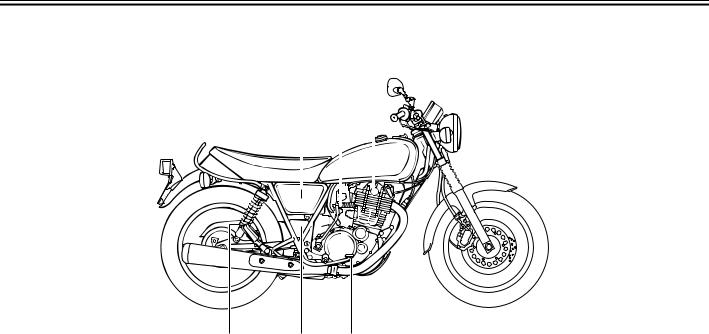
DESCRIPTION
EAU10421
Right view
2 |
1 |
2 |
3 |
4 |
||||||
|
|
|
|
|
|
|
|
|
|
|
|
|
|
|
|
|
|
|
|
|
|
|
|
|
|
|
|
|
|
|
|
|
|
|
|
|
|
|
|
|
|
|
|
|
|
|
|
|
|
|
|
|
|
|
7 |
6 |
5 |
1.Air filter element (page 6-12)
2.Kickstarter (page 3-10)
3.Kick indicator (page 5-1)
4.Headlight (page 6-31)
5.Brake pedal (page 3-6)
6.Owner’s tool kit (page 6-2)
7.Shock absorber assembly spring preload adjusting ring (page 3-12)
2-2
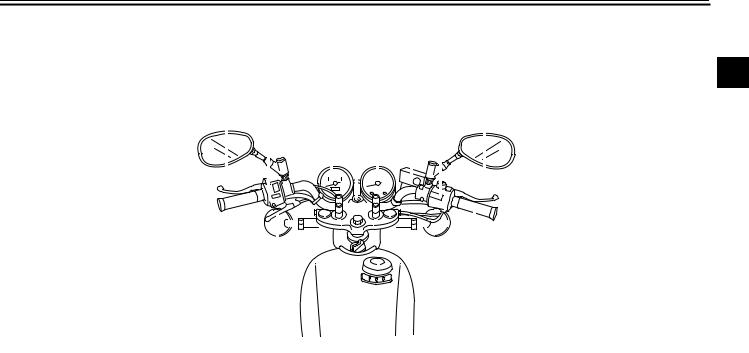
DESCRIPTION
EAU10431
Controls and instruments
2
1 |
2 |
3 |
4 |
|
|
5 |
|
6 |
7 |
8 |
|||||||||||||||||
|
|
|
|
|
|
|
|
|
|
|
|
|
|
|
|
|
|
|
|
|
|
|
|
|
|
|
|
|
|
|
|
|
|
|
|
|
|
|
|
|
|
|
|
|
|
|
|
|
|
|
|
|
|
|
|
|
|
|
|
|
|
|
|
|
|
|
|
|
|
|
|
|
|
|
|
|
|
|
|
|
|
|
|
|
|
|
|
|
|
|
|
|
|
|
|
|
|
|
|
|
|
|
|
|
|
|
|
|
|
|
|
|
|
|
|
|
|
|
|
|
|
|
|
|
|
|
|
|
|
|
|
|
|
|
|
|
|
|
|
|
|
|
|
|
|
|
|
|
|
|
|
|
|
|
|
|
|
|
|
|
|
|
|
|
|
|
|
|
|
|
|
|
|
|
|
|
|
|
|
|
|
|
|
|
|
|
|
|
|
|
|
|
|
|
|
|
|
|
|
|
|
|
|
|
|
|
|
|
|
|
|
|
|
|
|
|
|
|
|
|
|
|
|
|
|
|
|
|
|
|
|
|
|
|
|
|
|
|
|
|
|
|
|
|
|
|
|
|
|
|
|
|
|
|
|
|
|
|
|
|
|
|
|
|
|
|
|
|
|
|
|
|
|
|
|
|
|
|
|
|
|
|
|
|
|
|
|
|
|
|
|
|
|
|
|
|
|
|
|
|
|
|
|
|
|
|
|
|
|
|
|
|
|
|
|
|
|
|
|
|
|
|
|
|
|
|
|
|
|
|
|
|
|
|
|
|
10 |
9 |
1. |
Clutch lever (page 3-5) |
9. Throttle grip (page 6-13) |
2. |
Left handlebar switches (page 3-4) |
10.Decompression lever (page 3-11) |
3.Speedometer unit (page 3-3)
4.Main switch/steering lock (page 3-1)
5.Tachometer (page 3-4)
6.Front brake fluid reservoir (page 6-20)
7.Right handlebar switches (page 3-4)
8.Brake lever (page 3-6)
2-3
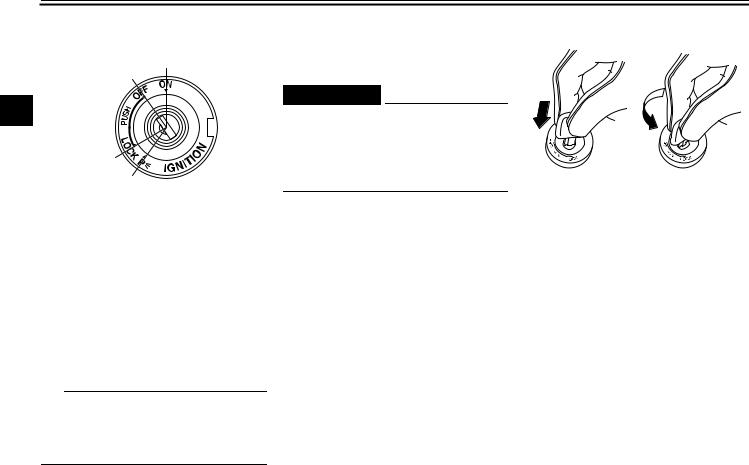
INSTRUMENT AND CONTROL FUNCTIONS
EAU10462
Main switch/steering lock
ON
OFF
3
LOCK
P
The main switch/steering lock controls the ignition and lighting systems, and is used to lock the steering. The various positions are described below.
EAU45111
ON
All electrical circuits are supplied with power, and the meter lighting and taillight come on, and the engine can be started. The key cannot be removed.
TIP
The headlight comes on automatically when the engine is started and stays on until the key is turned to “OFF”, even if the engine stalls.
EAU10662
OFF
All electrical systems are off. The key can be removed.
EWA10062
 WARNING
WARNING
Never turn the key to “OFF” or “LOCK” while the vehicle is moving. Otherwise the electrical systems will be switched off, which may result in loss of control or an accident.
EAU10685
LOCK
The steering is locked, and all electrical systems are off. The key can be removed.
To lock the steering
1 |
2 |
1.Push.
2.Turn.
1.Turn the handlebars all the way to the left.
2.Push the key in from the “OFF” position, and then turn it to “LOCK” while still pushing it.
3.Remove the key.
3-1
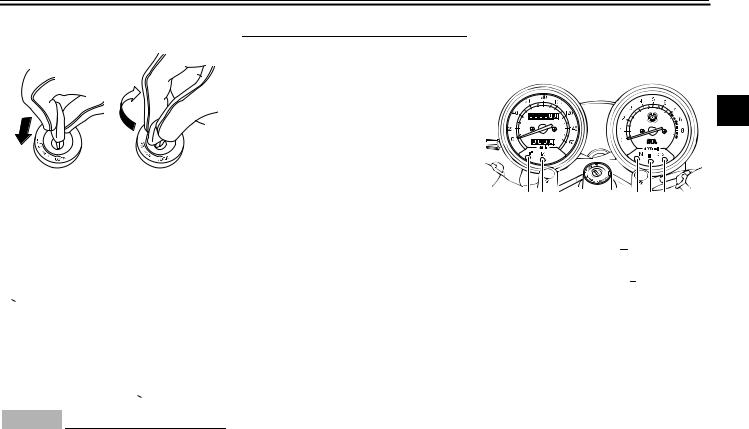
INSTRUMENT AND CONTROL FUNCTIONS
To unlock the steering
1 |
2 |
1.Push.
2.Turn.
may cause the battery to discharge. |
EAU49395 |
|
Indicator lights and warning lights
|
3 |
1 2 |
3 4 5 |
Push the key in, and then turn it to “OFF” while still pushing it.
EAU59680
 (Parking)
(Parking)
The hazard lights and turn signal lights can be turned on, but all other electrical systems are off. The key can be removed.
The steering must be locked before the key can be turned to “ ”.
”.
ECA20760
NOTICE
Using the hazard or turn signal lights for an extended length of time
1.Engine trouble warning light “ 
 ”
”
2.Fuel level warning light “ ”
”
3.Neutral indicator light “  ”
”
4.High beam indicator light “  ”
”
5.Turn signal indicator light “
 ”
”
EAU11021
Turn signal indicator light “
 ”
”
This indicator light flashes when the turn signal switch is pushed to the left or right.
EAU11061
Neutral indicator light “  ”
”
This indicator light comes on when the transmission is in the neutral position.
3-2
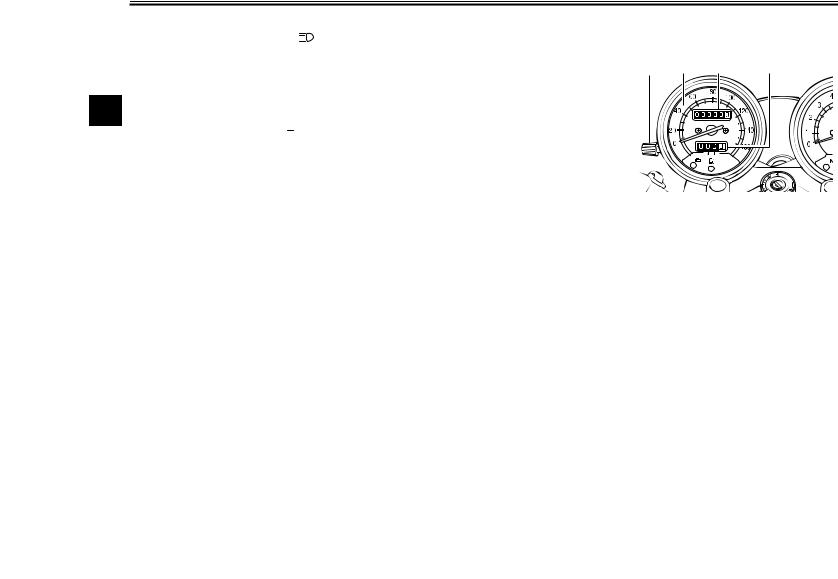
INSTRUMENT AND CONTROL FUNCTIONS
|
|
|
EAU11081 |
High beam indicator light “ |
|
|
” |
|
|||
|
|
||
This indicator light comes on when the |
|||
high beam of the headlight is switched |
|||
on. |
|
|
|
3 |
|
|
EAU11354 |
Fuel level warning light “ ”
”
This warning light comes on when the fuel level drops below approximately 2.2 L (0.58 US gal, 0.48 Imp.gal). When this occurs, refuel as soon as possible. The electrical circuit of the warning light can be checked by turning the key to “ON”. The warning light should come on for a few seconds, and then go off. If the warning light does not come on initially when the key is turned to “ON”, or if the warning light remains on, have a Yamaha dealer check the electrical circuit.
EAU11485
Engine trouble warning light “ 
 ”
”
This warning light comes on if a problem is detected in the electrical circuit monitoring the engine. If this occurs, have a Yamaha dealer check the self-diagnosis system.
The electrical circuit of the warning light
can be checked by turning the key to “ON”. The warning light should come on for a few seconds, and then go off. If the warning light does not come on initially when the key is turned to “ON”, or if the warning light remains on, have a Yamaha dealer check the electrical circuit.
EAU11631
Speedometer unit
1 |
2 |
3 |
4 |
1.Reset knob
2.Speedometer
3.Odometer
4.Tripmeter
The speedometer unit is equipped with a speedometer, an odometer and a tripmeter. The speedometer shows riding speed. The odometer shows the total distance traveled. The tripmeter shows the distance traveled since it was last set to zero with the reset knob. The tripmeter can be used to estimate the distance that can be traveled with a full tank of fuel. This information will enable you to plan future fuel stops.
3-3
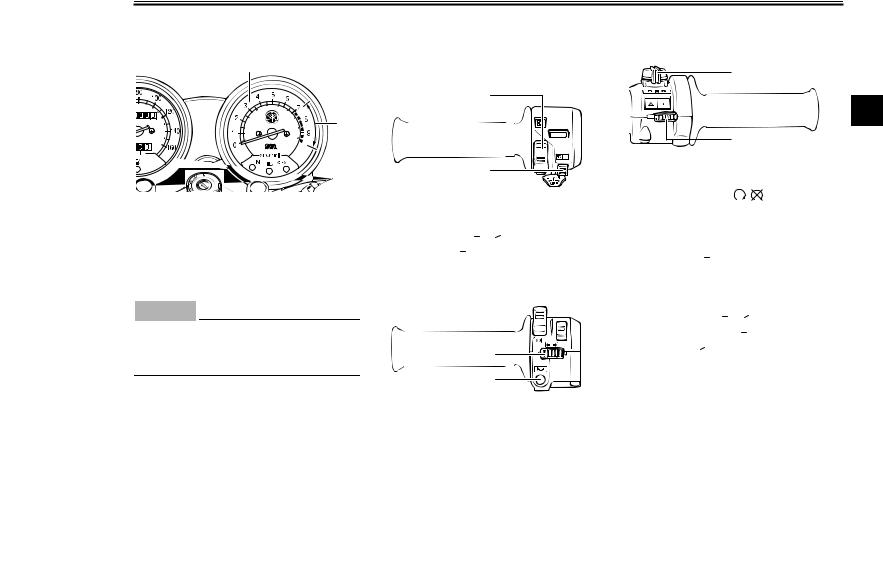
|
INSTRUMENT AND CONTROL FUNCTIONS |
||||
EAU11882 |
EAU1234F |
Right |
|
|
|
|
|
|
|
||
Tachometer |
Handlebar switches |
|
|
|
|
1 |
Left |
|
|
1 |
|
|
|
|
|
|
|
|
1 |
|
|
|
3 |
2 |
|
|
|
|
|
|
|
|
2 |
|
|
|
|
|
|
|
|
|
2 |
|
|
|
|
|
|
1. |
Engine stop switch “ |
/ |
” |
1.Tachometer
2.Tachometer red zone
The tachometer allows the rider to monitor the engine speed and keep it within the ideal power range.
ECA10032
1.Dimmer switch “  /
/  ”
”
2.Pass switch “  ”
”
Left
2. Hazard switch “ /
/ ”
”
EAU12351
Pass switch “  ”
”
Press this switch to flash the headlight.
EAU12401
NOTICE
Do not operate the engine in the ta-
chometer red zone.
1
Red zone: 7000 r/min and above
2
1. Turn signal switch “ /
/ ”
”
2. Horn switch “  ”
”
Dimmer switch “  /
/  ”
”
Set this switch to “  ” for the high beam and to “
” for the high beam and to “  ” for the low beam.
” for the low beam.
EAU12461
Turn signal switch “ /
/ ”
”
To signal a right-hand turn, push this switch to “ ”. To signal a left-hand turn, push this switch to “
”. To signal a left-hand turn, push this switch to “ ”. When released, the switch returns to the center position. To cancel the turn signal
”. When released, the switch returns to the center position. To cancel the turn signal
3-4
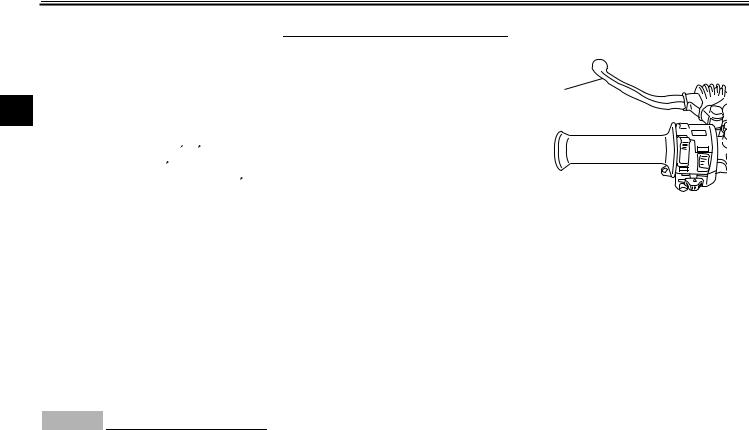
INSTRUMENT AND CONTROL FUNCTIONS
lights, push the switch in after it has re- tery may discharge. turned to the center position.
EAU12501
Horn switch “  ”
”
Press this switch to sound the horn.
3
EAU12661
Engine stop switch “ /
/ ”
”
Set this switch to “ ” before starting the engine. Set this switch to “
” before starting the engine. Set this switch to “ ” to stop the engine in case of an emergency, such as when the vehicle overturns or when the throttle cable is stuck.
” to stop the engine in case of an emergency, such as when the vehicle overturns or when the throttle cable is stuck.
EAU12766
Hazard switch “ ”
”
With the key in the “ON” position, use this switch to turn on the hazard lights (simultaneous flashing of all turn signal lights).
The hazard lights are used in case of an emergency or to warn other drivers when your vehicle is stopped where it might be a traffic hazard.
ECA10062
EAU12821
Clutch lever
1
1. Clutch lever
The clutch lever is located at the left handlebar grip. To disengage the clutch, pull the lever toward the handlebar grip. To engage the clutch, release the lever. The lever should be pulled rapidly and released slowly for smooth clutch operation.
The clutch lever is equipped with a clutch switch, which is part of the ignition circuit cut-off system. (See page 3-13.)
NOTICE
Do not use the hazard lights for an extended length of time with the engine not running, otherwise the bat-
3-5

INSTRUMENT AND CONTROL FUNCTIONS
EAU12872
Shift pedal
1 |
1. Shift pedal
The shift pedal is located on the left side of the motorcycle and is used in combination with the clutch lever when shifting the gears of the 5-speed con- stant-mesh transmission equipped on this motorcycle.
EAU12892
Brake lever
1
1. Brake lever
The brake lever is located on the right side of the handlebar. To apply the front brake, pull the lever toward the throttle grip.
EAU12942
Brake pedal
1
3
1. Brake pedal
The brake pedal is on the right side of the motorcycle. To apply the rear brake, press down on the brake pedal.
3-6

INSTRUMENT AND CONTROL FUNCTIONS
EAU13125
Fuel tank cap
To remove the fuel tank cap
3 |
1 |
|
|
2

1.Unlock.
2.Fuel tank cap lock cover
Slide the fuel tank cap lock cover open, insert the key into the lock, and then turn it 1/4 turn clockwise. The lock will be released and the fuel tank cap can be removed.
To install the fuel tank cap
1.Insert the fuel tank cap into the tank opening with the key inserted
in the lock and with the “ ” mark facing forward.
” mark facing forward.
1
2
1.“ ” mark
” mark
2.Fuel tank cap lock cover
2.Turn the key counterclockwise to the original position, remove it, and then close the lock cover.
TIP
The fuel tank cap cannot be installed unless the key is in the lock. In addition, the key cannot be removed if the cap is not properly installed and locked.
EWA10132
 WARNING
WARNING
Make sure that the fuel tank cap is properly installed before riding. Leaking fuel is a fire hazard.
EAU13222
Fuel
Make sure there is sufficient gasoline in the tank.
EWA10882
 WARNING
WARNING
Gasoline and gasoline vapors are extremely flammable. To avoid fires and explosions and to reduce the risk of injury when refueling, follow these instructions.
1.Before refueling, turn off the engine and be sure that no one is sitting on the vehicle. Never refuel while smoking, or while in the vicinity of sparks, open flames, or other sources of ignition such as the pilot lights of water heaters and clothes dryers.
2.Do not overfill the fuel tank. When refueling, be sure to insert the pump nozzle into the fuel tank filler hole. Stop filling when the fuel reaches the bottom of the filler tube. Because fuel expands when it heats up, heat from the engine or the sun can cause fuel to spill out of the fuel tank.
3-7
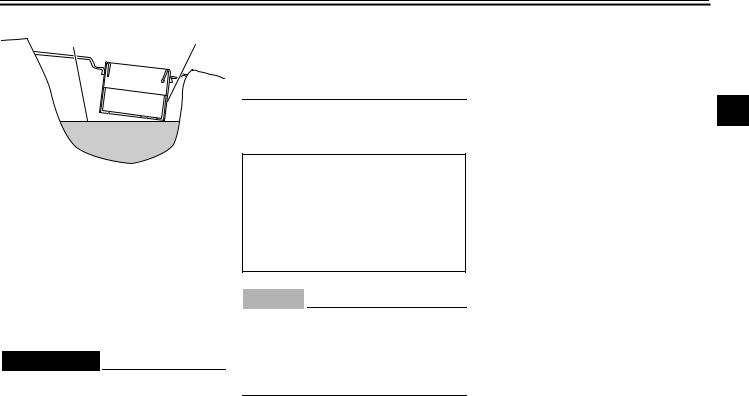
INSTRUMENT AND CONTROL FUNCTIONS
1 |
2 |
your eyes, see your doctor immedi- |
ately. If gasoline spills on your skin, |
||
|
|
wash with soap and water. If gaso- |
|
|
line spills on your clothing, change |
|
|
your clothes. |
1.Maximum fuel level
2.Fuel tank filler tube
3.Wipe up any spilled fuel immediately. NOTICE: Immediately wipe off spilled fuel with a clean, dry, soft cloth, since fuel may deteriorate painted surfaces or plastic
parts.[ECA10072]
4.Be sure to securely close the fuel tank cap.
EWA15152
 WARNING
WARNING
Gasoline is poisonous and can cause injury or death. Handle gasoline with care. Never siphon gasoline by mouth. If you should swallow some gasoline or inhale a lot of gasoline vapor, or get some gasoline in
EAU57690
Recommended fuel:
Regular unleaded gasoline (Gasohol (E10) acceptable)
Fuel tank capacity:
12.0 L (3.17 US gal, 2.64 Imp.gal)
Fuel reserve amount (when the fuel level warning light comes on):
2.2 L (0.58 US gal, 0.48 Imp.gal)
ECA11401
NOTICE
Use only unleaded gasoline. The use of leaded gasoline will cause severe damage to internal engine parts, such as the valves and piston rings, as well as to the exhaust system.
Your Yamaha engine has been designed to use regular unleaded gasoline with a research octane number of 95 or higher. If knocking (or pinging) occurs, use a gasoline of a different brand
or premium unleaded fuel. Use of unleaded fuel will extend spark plug life and reduce maintenance costs.
Gasohol
There are two types of gasohol: gaso- 3 hol containing ethanol and that contain-
ing methanol. Gasohol containing ethanol can be used if the ethanol content does not exceed 10% (E10). Gasohol containing methanol is not recommended by Yamaha because it can cause damage to the fuel system or vehicle performance problems.
3-8
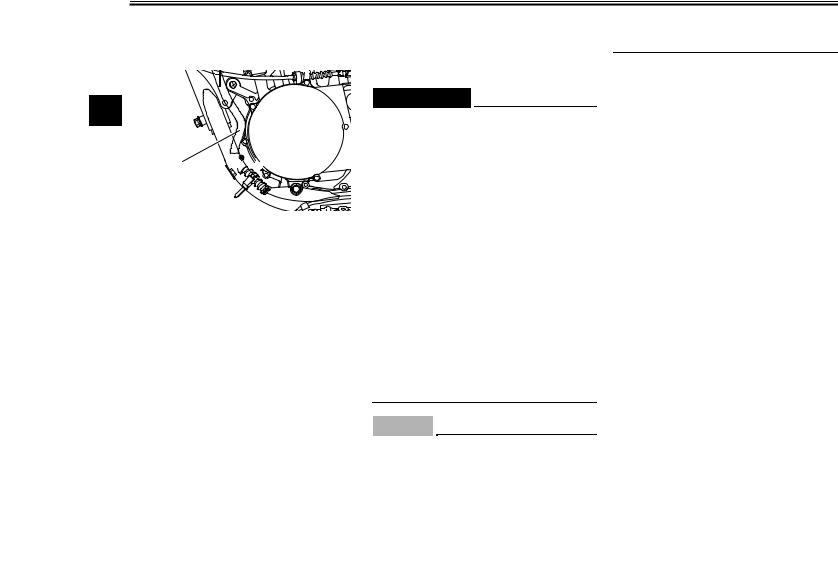
INSTRUMENT AND CONTROL FUNCTIONS
EAU39453
Fuel tank breather/overflow hose 
3
1



1.Fuel tank breather/overflow hose
Before operating the motorcycle:
Check the fuel tank breather/overflow hose connection.
Check the fuel tank breather/overflow hose for cracks or damage, and replace it if necessary.
Make sure that the end of the fuel tank breather/overflow hose is not blocked, and clean it if necessary.
EAU13434
Catalytic converter
This model is equipped with a catalytic converter in the exhaust system.
EWA10863
 WARNING
WARNING
The exhaust system is hot after operation. To prevent a fire hazard or burns:
Do not park the vehicle near possible fire hazards such as grass or other materials that easily burn.
Park the vehicle in a place where pedestrians or children are not likely to touch the hot exhaust system.
Make sure that the exhaust system has cooled down before doing any maintenance work.
Do not allow the engine to idle more than a few minutes. Long idling can cause a build-up of heat.
ECA10702
NOTICE
pairable damage to the catalytic converter.
Use only unleaded gasoline. The use of leaded gasoline will cause unre-
3-9
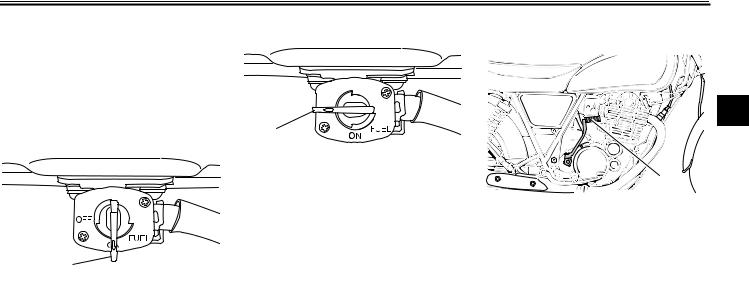
INSTRUMENT AND CONTROL FUNCTIONS
EAU59490
Fuel cock
The fuel cock regulates and filters the fuel supply from the fuel pump to the fuel injector.
The fuel cock has two positions:
ON |
1 |
1. Arrow mark positioned over “ON”
With the lever in this position, fuel will be supplied to the engine. Normal operation is done with the lever in this position.
OFF |
1 |
1. Arrow mark positioned over “OFF”
With the lever in this position, fuel will not flow. Use this lever position when performing certain maintenance work or when storing the vehicle for a prolonged time.
EAU13651
Kickstarter
3
1
1. Kickstarter
To start the engine, fold out the kickstarter lever, move it down lightly with your foot until the gears engage, and then push it down smoothly but forcefully. This model is equipped with a primary kickstarter, allowing the engine to be started in any gear if the clutch is disengaged. However, shifting the transmission into the neutral position before starting is recommended.
3-10
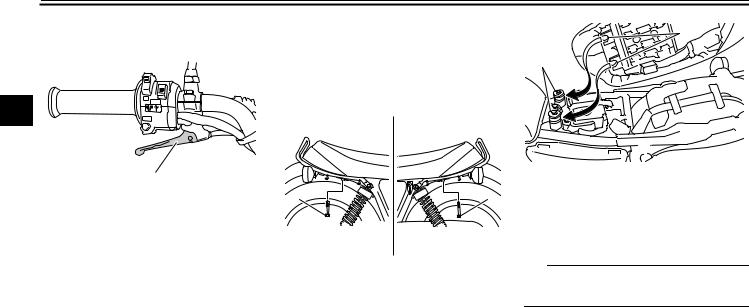
INSTRUMENT AND CONTROL FUNCTIONS
EAU13701 |
EAU13961 |
Decompression lever |
Seat |
|
|
To remove the seat |
||
|
|
Remove the bolts, and then pull the |
||
3 |
|
seat off. |
||
|
|
|
||
1 |
|
|
|
|
1. Decompression lever |
|
1 |
1 |
|
|
|
|
||
When this lever is pulled, the exhaust |
|
|
||
valve is forced open so that the com- |
|
|
||
pression pressure can be |
reduced. |
1. |
Bolt |
|
This allows the piston to be moved just |
||||
|
|
|||
past the compression stroke before |
To install the seat |
|||
kick starting. (See page 5-1.) |
|
|||
|
1. Insert the projections on the front |
|||
|
|
|||
|
|
|
of the seat into the seat holders as |
|
|
|
|
shown. |
|
2 |
1 |
1.Seat holder
2.Projection
2.Place the seat in the original position, and then tighten the bolts.
TIP
Make sure that the seat is properly secured before riding.
3-11

INSTRUMENT AND CONTROL FUNCTIONS
EAU14883
Adjusting the shock absorber assemblies
EWA10211
 WARNING
WARNING
Always adjust both shock absorber assemblies equally, otherwise poor handling and loss of stability may result.
Each shock absorber assembly is equipped with a spring preload adjusting ring.
ECA10102
NOTICE
To avoid damaging the mechanism, do not attempt to turn beyond the maximum or minimum settings.
Adjust the spring preload as follows. To increase the spring preload and thereby harden the suspension, turn the adjusting ring on each shock absorber assembly in direction (a). To decrease the spring preload and thereby soften the suspension, turn the adjusting ring on each shock absorber assembly in direction (b).
Align the appropriate notch in the adjusting ring with the position indicator
on the shock absorber.
|
1 |
(a) |
1 |
2 |
|
(b) |
3 |
|
4 |
|
5 |
1. Spring preload adjusting ring
Spring preload setting:
Minimum (soft): 1
Standard:
1
Maximum (hard): 5
EAU15306
Sidestand
The sidestand is located on the left side of the frame. Raise the sidestand or lower it with your foot while holding the
vehicle upright.
3
TIP
The built-in sidestand switch is part of the ignition circuit cut-off system, which cuts the ignition in certain situations. (See the following section for an explanation of the ignition circuit cut-off system.)
EWA10242
 WARNING
WARNING
The vehicle must not be ridden with the sidestand down, or if the sidestand cannot be properly moved up (or does not stay up), otherwise the sidestand could contact the ground and distract the operator, resulting in a possible loss of control. Yamaha’s ignition circuit cut-off system has been designed to assist the operator in fulfilling the responsibility of raising the sidestand before starting off. Therefore, check this system regularly and have a
3-12
